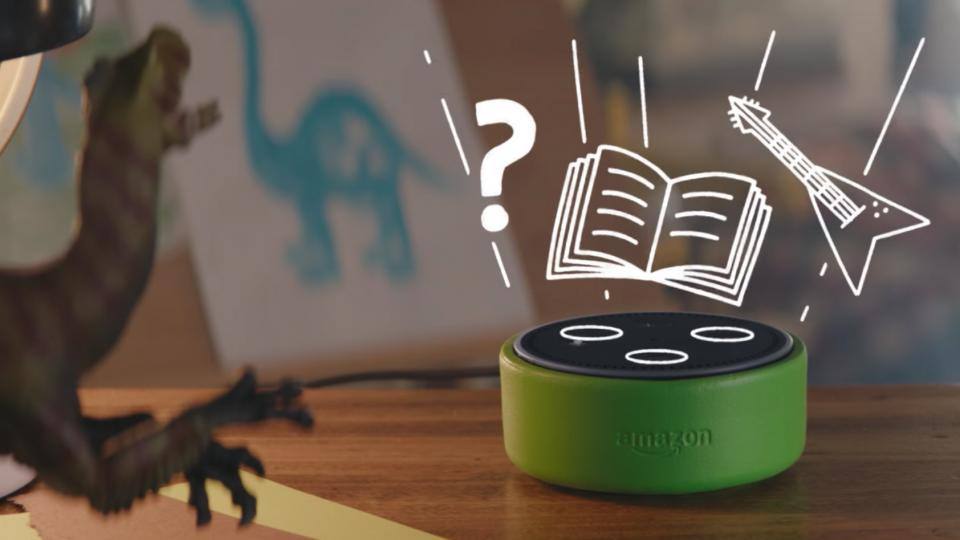One of the newest trends that is getting a lot of attention lately involves controlling devices with our voices. Amazon is just one of many that are working to make their VUI (voice user interface) more intelligent and user-friendly. One way Amazon is doing this is by providing a host of skills to their personal intelligent assistant Alexa. Alexa runs on Amazon’s Echo, Dot, and Tap devices. You may know someone who has received an Echo, Dot, or Tap as a gift recently and wondered what all the commotion is about. I didn’t pay too much attention myself until I received a Dot as a gift. Then I started discovering the many ways Alexa could be used in the classroom…and possibly as your new teaching assistant.
Out of the Box
Once I unboxed my Dot and connected it to the internet via my wireless network, I was able to get Alexa to provide basic information and perform simple tasks:
- Alexa, what is the weather for tomorrow?
- Alexa, what is the capital of Alaska?
- Alexa, what is 37 times 414?
- Alexa, tell me a riddle.
- Alexa, set a ten-minute timer.
- Alexa, sing me a song.
Classroom Uses
There are many ways that Alexa can help you in the classroom even in addition to adding skills (which we’ll highlight in the next section).
- Get rid of all of your dice, cards, coins, and other probability tools as Alexa can take care of that for you. Just ask her to flip a coin, pick a card, roll a dice, or pick a random number between 1 and whatever top number you want.
- Use Alexa in your classroom to support literacy by having students ask her how to spell a specific word, suggest a synonym, or provide a definition.
- Social studies students can skip an internet search by asking Alexa simple geography and civics questions.
- Math students can use Alexa to check their work when they’ve finished an assignment, and science students will find Alexa is great at converting units of measurements.
- If it’s been a stressful day, you can ask Alexa to play a track like “Nature Sounds for Relaxation” and give your students the opportunity to unwind.
- To help your students keep up with current events, set up daily news briefings from the app.
- Splurge for an Audible account (free 30-day trial; $14.95/month after that) and have Alexa read an audiobook to the class. Or have her read Wikipedia articles to students in need of reading support. The device can even read any Kindle book that you own (both free and paid), if you don’t mind the robot voice.
- Encourage students to become more knowledgeable about a wide variety of subjects with an “Alexa Fact of the Day.” Each day (or class period), a different student gets to ask Alexa a question about any (appropriate) subject the student is interested in. Have students keep track of these facts in a journal and then quiz each other about them at the end of the month. They can even use these facts to stump their parents.
- This device can also be a great way for kids to practice speaking as they must enunciate pretty well in order to be understood. You can also have them practice their questioning skills by thinking of the question they want to ask before asking it.
Consider adapting your rule of “Ask three before me” to “Ask Alexa and three before me.” You’ll find more ideas of how to use the basics of the tech by visiting Erintigration’s site.
An Alexa Just for Kids
 On April 25, Amazon announced a new Alexa designed just for children. The Echo Dot Kids Edition, which costs $79.99 and is geared toward ages 5-12, is available for pre-order and starts shipping on May 9.
On April 25, Amazon announced a new Alexa designed just for children. The Echo Dot Kids Edition, which costs $79.99 and is geared toward ages 5-12, is available for pre-order and starts shipping on May 9.
There are a lot of nice features in this new Dot, including Parental Controls, a case, and a year of FreeTime Unlimited, which includes great resources like kids’ Audible books, ad-free music stations, and fun, kid-friendly alarms. The device can decipher “kid speak” and rewards those who are polite in asking for something. It is also cautious in answering delicate questions such as “Is there a Santa Claus?” or “Where do babies come from?” The device comes set to not allow any Amazon ordering by the children and does not collect any personal data, which may set your mind a little more at ease.
If your student or child loves LEGO Duplo blocks, you can even add an Alexa story skill that guides younger children (aged 2 to 5) through playtime with the blocks. The customizable stories are themed around animals or vehicles. Alexa can encourage them to build creatively or recognize colors.
ClassAlexa
An enterprising set of teachers from 31 different states has now created ClassAlexa. Defined as “an extra pair of hands for busy K-to-8 teachers,” the add-on has hundreds of activities. The teacher can ask Alexa for an activity, like a ten-minute countdown or a word problem. Within a few seconds, Alexa “speaks back” the activity to the class, providing prompts as needed. Activities include brain breaks, math and ELA review questions, transitions, discussion prompts, countdowns and timers, social/emotional support, random student pickers, voice note taker, and class fun and games (coming soon).
The Starter version is free and includes five of the most popular activities with limited variations and a customizable random student picker. The Full Member version is just $20 before August 1 ($40 a year after that) and includes everything.
This blog was updated with additional content on July 5, 2018.


Comments are closed.